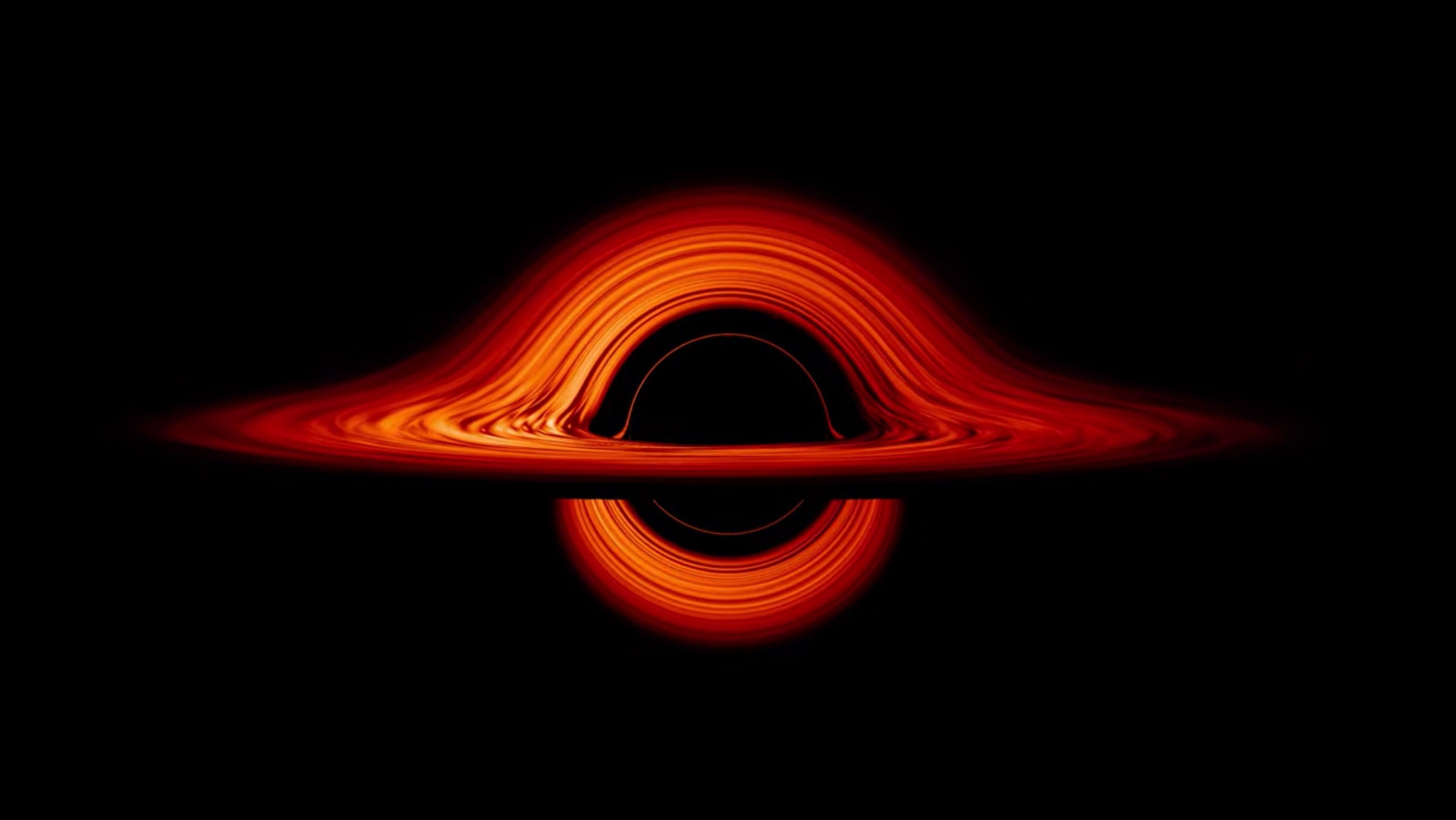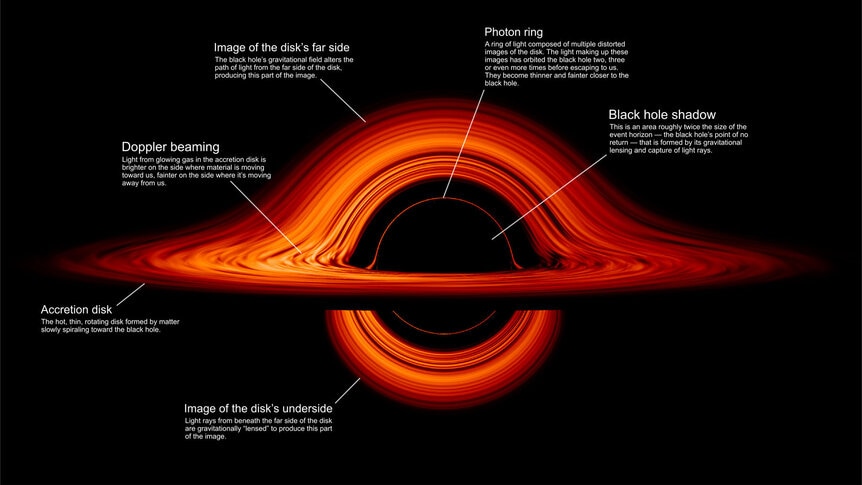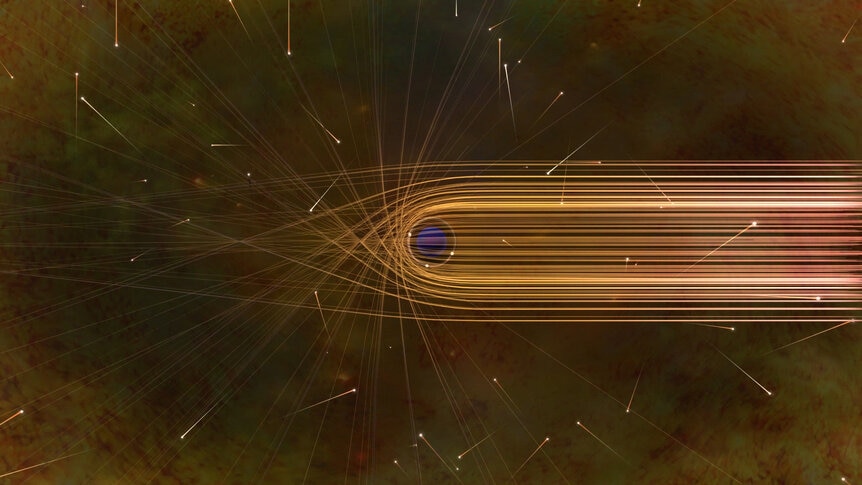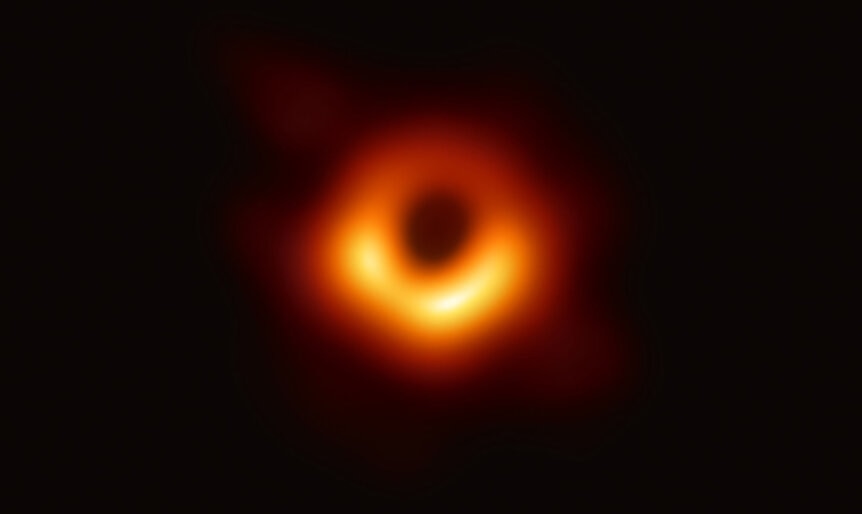Create a free profile to get unlimited access to exclusive videos, sweepstakes, and more!
What does a black hole look like up close?

What would a black hole look like if you were up close to it?
There are several ways to answer this question. One way is: nothing. It’s black, so it won’t look like anything.
This may be unsatisfying.
Another way is: it doesn’t matter, because in a few milliseconds you’ll be dead anyway.
That’s a little dark, and though true, also unsatisfying.
If you’re a scientist, though, the answer is more complicated. We don’t have to get close to a black hole to figure out what it looks like, so defying our own demise isn’t necessary. And if we posit the black hole is actively eating, say, a big cloud of gas, then we can figure out what it looks like.
You need a lot of math and physics, including relativistic physics, radiative transfer physics (basically, how things glow), and a good computer to run through the fierce calculations, but what you get is something so cool it makes the brain-and-spacetime-twisting physics worth it.
Because it looks like this:
Coooooooool.
So what are you seeing here? Chaos, heat, and gravity, all stirred together by relativity.
More specifically, you’re seeing the weird optics generated when a black hole is surrounded by a ring of gas it’s consuming, called the accretion disk. This was released by NASA in honor of #BlackHoleWeek, which I have an opinion about:
But despite that, this sim is amazing, and worth examining. Let’s take a look at all this from the center out.
At the very center is the black hole itself. You can’t see it (see paragraph 2 above). Every black hole has a minimum distance from it where, to escape its gravity, you’d need to move at the speed of light. Nothing can do this, which is why black holes are black (and why they’re holes, for that matter). This distance is called the event horizon.
However, the big black circle in the middle is actually bigger than the event horizon. Any photon (a particle of light) that gets too close to the black hole actually goes into orbit around it before eventually falling in, and doesn’t make it back out to us. This region is called the photon sphere (also somewhat misleadingly called the black hole’s shadow) and is about 2.5 times bigger than the event horizon (this is for a rotating black hole; if it’s not rotating, the photon sphere is only 1.5 times bigger; the reasons for this are, unsurprisingly, complex).
Technically speaking, if you were inside the photon sphere (and not torn apart by the ridiculously strong tides or just pulled right in) and looking directly ahead of you, you could see the back of your own head! The photons from the back of your head would orbit around the black hole, and then come at you from ahead of you. That would be… disconcerting.
A point: a lot of people get confused about seeing any light from a black hole. Light cannot escape a black hole if it gets too close, inside the event horizon (or the photon sphere, depending on circumstances). But outside that distance light is free to travel away… but not without paying a price. Let’s find out what that toll is.
Back to the sim, and still moving outward, just outside that photon sphere is a narrow ring of light, called the photon ring. This is light from the accretion disk, where the photons that headed in toward the black hole stay just outside the photon sphere limit, so they orbit the black hole a few times before coming back out. There’s a gap around it because photons that stay well outside the photon sphere just keep going — their path is bent severely by the black hole’s gravity, but not enough to head toward us. So we see no light from that region.
Outside the photon sphere we see the light from the accretion disk itself… but it’s a mess. Remember, it’s a flat disk around the black hole, like Saturn’s rings. But we see the disk by the light it emits, and that’s having merry hell played on it by the black hole.
In front of the black hole the disk looks relatively (ha!) normal. That light goes from the disk to us, straight out of the black hole’s gravity well, so it’s not as distorted. If you follow it around to the right, though, it suddenly kinks upward, forming an arch over the black hole. That’s the backside of the disk! Normally you wouldn’t see it, since it’s behind the black hole. But some of the light from that part of the disk goes around and over the black hole, bent by the fierce gravity in a direction toward us, allowing us to see it.
That light in the arch above the black hole is coming from the topside of the accretion disk. Light from the underside also goes around the black hole, but it’s bent around the bottom of the black hole, so we see that part of the disk under the black hole as well. That looks like a smaller circle than the upper one, but this size and geometry depends on the angle were looking from. The shape of these two arches depends on the viewing angle, because the way the light gets bent around the black hole changes the way we see it as we move up or down relative to the disk itself. You can see that happening in the video as the viewing angle changes.
There’s one more thing to note. In this sim, the gas in the accretion disk orbits the black hole from left to right. That’s important! Can you see how the disk on the left looks brighter than it does on the right? That’s a real effect, called relativistic beaming. I’ve written about it before:
There’s an effect called relativistic beaming, caused by the incredibly rapid motion of the material as it orbits just outside the black hole. If you hold a light bulb in front of you, the light expands in a sphere, in all directions, But if that light bulb is moving near the speed of light, the light we see emitted from it appears to be beamed, like a flashlight, aimed into the direction it’s moving. This bizarre effect means that an object headed toward you at close to the speed of light appears brighter, because more of its light is focused toward you, and something moving away appears darker, because its light is focused away from you.
The gas on the left is headed toward you, so some of its light that would otherwise miss you is beamed toward you, making it look brighter. The gas on the left is heading away from you, so its light is beamed even more away from you, dimming it.
If all this sounds familiar, that may be because you’re thinking of the very first image of a photon sphere of a black hole — in this case, the one in the center of the galaxy M 87, 55 million light years away, taken by the Event Horizon Telescope, an array of radio telescopes across the planet.
Fuzzy, but it shows the same features! Stay tuned, too, because soon we’ll be seeing more, and more clear, images of these objects.
So I think at this point it’s OK to take a moment and think, “Black holes are weird.”
But hey, that’s nature. The Universe isn’t under any obligation to obey our “common” sense, as uncommon and nonsensical as that might be. But when you take the time to really look at the Universe, observe it, find the patterns, the math behind those patterns, and the physics that math implies — that math demands — then even the weirdest things in the Universe become understandable.
That’s a nice to thought to have, perhaps even comforting, in the last few milliseconds before you leave the Universe forever. Have a nice trip down!

















